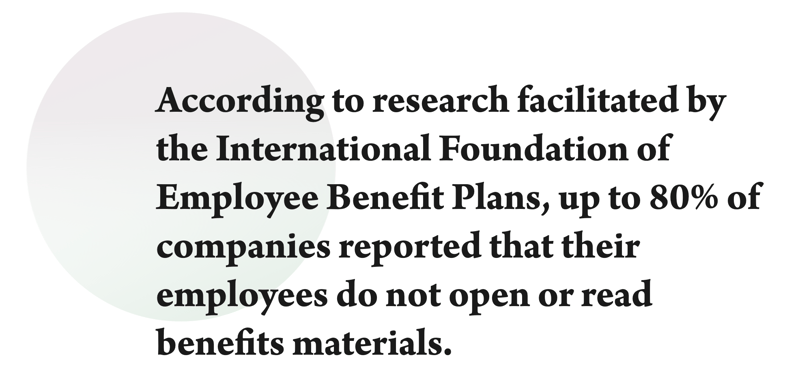
Are Your Benefits Competitive?
In a competitive market where you are up against competition to attract and retain employees, the benefits you offer may make or break your candidate pipeline. According to our recent survey, we learned the top ways manufacturers in the Upper Midwest are attracting and retaining employees:
- Competitive pay and wage increases
- Robust benefits (in some cases, 100% healthcare benefits coverage)
- Employee Stock Ownership Plan (ESOP)
- Employment Sponsored Retirement Plans/401(k)
- Employee Assistance Program (EAP)
- Career growth path/opportunities for advancement
- Safe/clean environment
- Spot bonuses
- Referral bonuses
- Signing bonuses
- Flexible hours (this is especially important with the current state of childcare)
- Training
- Updated and improved vacation policies
- Gifts, awards, and recognition for individual employees

This Forbes article outlines the fact that only about half of employees understand their benefits. This is a huge deal when it comes to retention. If employees don’t understand the benefits they’re offered, they don’t know what they’re turning down by working for a different company. Not only is it critical to have benefits in place, but it is vital to promote these benefits openly and often. Think about the format that you deliver this information. If employees aren’t reading the company newsletter, perhaps you need to put digital screens in the break room to display the information.
A study done by the SA Journal of Industrial Psychology showed that the most important individual motivational reward for blue collar employees is paid holidays. This is followed by work with more responsibility and wage increases, both ranked in the second place:
- The most important individual motivational rewards for frontline employees are retirement plans, cash incentives, wage increases, job security and paid holidays, all of them ranked in first place.
- The most important motivational reward category for both blue-collar and frontline employees is indirect financial rewards (fringe benefits), followed by social and direct financial rewards (direct pay, cash incentives, direct benefits)
- The least important motivational reward category for both blue-collar and frontline employees is consumable rewards.
Let’s dive into just a few of these frequently offered benefits:

1. Competitive Pay
Offering competitive pay to employees is an essential, and sometimes overlooked, necessity within organizations. As mentioned previously, pay isn’t always a primary factor for employee loss, but it is not something that can be overlooked, especially in the competitive landscape of manufacturing.
So what does “competitive pay or salary” mean for your company? First, you need some guardrails to know where your pay offerings land among organizations of similar size, geographic landscape, socioeconomic factors of employees and so on. Creating a competitive compensation structure for your company is not a “one-and-done” activity, but an ongoing practice that should be informed by recent research, data, and trends in similar industries. There are a multitude of resources available to inform, and guide, your compensation structure.
Companies such as Payscale.com offer a multitude of resources. Here are the highlights from their article on a simple way to conduct a competitive wage analysis.
- Set goals. Know why you’re doing an analysis. Are you seeking legal compliance or wanting to address pay inequities? Or perhaps you’re seeking a way to build a compensation system and process for assessing wages on a regular basis. Whatever you’re setting out to do, make sure your goals are Specific, Measurable, Attainable, Relevant, and Time-based.
- Examine your organization’s current pay practices and philosophy. How were current wages determined? Is there a known, and consistent, methodology in determining wages and pay increases? How is pay determined for new employees? Unsure if you’re doing it “right?” Here’s an article about compensation practices to inform your review.
- Gather data. Leaving compensation to gut instinct is expensive and time consuming. And, it’s likely a big factor in poor employee retention and performance. Employees crave, and need, visibility to compensation parameters. Data resides at the heart of establishing a practice of compensation analysis and implementation. Two factors to consider when selecting market data sources: is it current, accurate and relevant? And, does it align with your organization, jobs, geography and industry? “How to perform compensation benchmarking and set salary ranges” is a helpful whitepaper on available data sources to inform your competitive salary analysis.
- Establish pay ranges by job categories. Use the data you’ve gathered to inform pay ranges for job categories. Market data will typically reflect a midpoint for pay, and from there you can begin to see how experience, education, and longevity might inform where employees fall within the categories. Again, pay ranges shouldn’t be set by instinct or good intentions, but should be informed by data and best practices. An experienced compensation analyst, typically with a human resources or finance background, is a helpful partner in establishing these guidelines.
- Follow through. Compare employees’ salaries with the ranges you’ve established and determine if adjustments are needed. Watch for both underpaid, and overpaid, employees. Where can small adjustments be made and where are the most dominant pain points? Salary discrepancies can be remedied with one-time adjustments or incremental adjustments overtime and in some cases, reworking the job entirely in order to more closely align with market data.
- Communicate your compensation strategy. It’s important to remember that not all leaders and managers are comfortable discussing pay. So, starting with information sessions with this group can arm them with information and set the tone for how this information will be shared with teams and individual employees. In addition, determine what compensation information and practices can be shared and available broadly at all times, within communication vehicles such as an intranet, employee handbook or company newsletter.
Salary surveys, such as this one by Industry Week, can be a good place to start to ground yourself with baseline information and awareness across a broad set of companies. It’s important to remember that these kinds of surveys are not a one-to-one comparison to your company but rather a pulse on averages or comparison of similar companies.
In addition to compensation-specific resources, it’s critical to pay attention to world and economic circumstances and even community trends that might affect individuals, families and companies. As an example, a surge in gas prices may dramatically influence recruiting and maintaining employees from outside the local community, as it directly impacts the costs of transportation to and from work. In addition, the COVID-19 pandemic introduced new challenges for families related to childcare, distance learning and parents working from home. Consider how these elements affect your employees’ livelihood and whether the company addresses this with compensation adjustments.
As previously stated, a small percentage of employees surveyed state pay as the primary reason for a job change. However, if your compensation structure is left idle, it won’t take long for it to become noticeably outdated and beneath the standards of other employers who invest the time and energy to actively study and adjust a compensation structure that is competitive, relevant and timely.

2. Employment Sponsored Retirement Plans
Workplace retirement plans not only help set you apart from competitors, but they offer long-lasting impact to your workforce. Employers have found these plans can improve productivity and loyalty from your current employees and attract top talent from outside your business. Implementing a 401k plan indicates your commitment to help employees build future security.
Benjamin Barrett, Financial Advisor at Edward Jones, shares: “The importance of retirement plans are often overlooked. ‘Setting Every Community Up for Retirement Enhancement (SECURE) Act’ was recently passed in 2019. It’s intent is to improve retirement savings. One of the SECURE Act’s most attractive provisions has made it less expensive for many small businesses to start new retirement plans, including 401ks, SEP IRAs and SIMPLE IRAs. Each of these workplace retirement plans serves a purpose, depending on the size and structure of your business.
Most plans include the opportunity for the employer to hire a local financial professional to work directly with your staff. That professional helps with onboarding new employees into the plan, and providing personalized education and resources. Employers who offer quarterly educational events tailored to their employees have seen increased loyalty. During these events, employees have the option to meet one-on-one with the financial professional.
Every company is different, which requires a different approach to rolling out a 401k plan. A common issue we see is employee disengagement and confusion when it comes to retirement plans. The worst thing a company can do is send out an email or hand out a pamphlet about the available options. Without proper education, employees likely won’t understand or see value in this benefit.”

3. Career Paths
One sign of successful leadership is the vision, and follow through, to invest in employees’ development and future. A proven way to develop employees is through career paths. Career paths can also increase productivity and retention and also employee happiness.
What are career paths? Career paths are structured development plans aimed to identify, and nurture, employees’ interest and career potential within the company. It involves honest assessment of employees’ skills, experiences, goals, personal competencies as well as needed knowledge and gaps.
If your company is large, with multiple departments, management layers and frequent job openings, career paths can be an essential tool in succession planning and helping employees move to their next level.
Smaller organizations can offer career paths by thinking of “sideways,” or lateral, development opportunities such as learning and training across teams or opportunities to lead cross functional teams toward a company initiative. These career path opportunities can build depth and breadth of knowledge for a “deeper bench” of employees who are primed to step up when opportunities arise.
Employees and leaders who engage in career path development conversations gain valuable insight about:
- Current skills and competencies
- Vertical or lateral growth opportunities
- Resources, training or tools needed to fill gaps or to grow knowledge
- Gaps in skills and competencies
So after you’ve discovered the above, now what? It’s important to implement ways to keep career path conversations front and center. Here several ways you can do this:
- Check-in during one-on-one meetings. What is going well related to career development and learning? What are the challenges? And, what immediate actions are needed to keep the development on track?
- Support learning opportunities. Unfortunately, training and learning opportunities can easily be pushed aside to prioritize day-to-day demands of the work. Research, and schedule, training and learning opportunities in advance and schedule around them. Maintaining them as a priority will demonstrate your commitment to the employees and their futures. Can’t seem to find the time for learning and training? Some organizations have gained momentum in this area by adopting “certification days.” These can be full- or half-day commitments where large groups of employees embark on specific training opportunities together. Is there a slow season to your business? This could be an ideal time to incorporate this kind of education practice into your organization.
- Watch for, and leverage, high performers. Sometimes small learning opportunities such as leading a team or a project, researching a new idea or mentoring a new employee can help tap into highly motivated, top performing employees. These employees often crave the opportunity to flex their knowledge and experiences to improve a process, educate others and so on. This is definitely a form of career path development and also a way to recognize employees for their contributions.
- Prioritize development. It’s important to disassociate career path development with “more work.” It will be counterproductive if employees see career development as having to do more or consistently outperform others. This isn’t the purpose or driving factor of development. Rather, you can ensure that development is seen, and maintained, as a priority by making space for it within employees’ work day. This can be achieved by removing administrative tasks or bringing tasks together for efficiency or reassigning small projects.
Career paths are not all about vertical or lateral movement within an organization. Keep in mind that career paths can help leverage talent, identify skill gaps, and improve productivity and retention. Keeping these factors in mind will help ensure your approach to career paths is creative and strategic in the ways it can serve individuals as well as company needs.

4. Employee Assistance Program (EAP)
What is an EAP? Besides being a hidden gem in most companies, an employee assistance program is typically a “voluntary, work-based program that offers free and confidential assessments, short-term counseling, referrals, and follow-up services to employees who have personal and/or work related problems,” according to the U.S. Office of Personnel Management.
An EAP rarely gets the stage time it deserves. The offering may be conveyed through a loose pamphlet in the employee hiring packet or a brochure pinned to a billboard in the company break room, and thus in many cases, remains an underutilized, underrepresented benefit.
Ensure that your management and leadership know how your company’s EAP works. Encourage and remind them to share with their team members regularly and to watch for individual instances when the program could be beneficial. Referrals are typically as seamless as providing a phone number, website or email as a place to start.
The value and contribution of an EAP cannot be overstated. Employees bring their whole selves to the workplace, and an EAP can offer services to help manage all facets of life and its challenges. From counseling services to financial resources and childcare education, EAP programs often cover a gamut of areas and topics. In addition, most EAPs do not limit services to personal matters, but are open to helping to address workplace conflicts and questions as well.
EAPs are always helpful, but it’s certainly obvious how incredibly valuable they are today, given the additional challenges of the COVID-19 pandemic. Offering EAP services should be done broadly with consistent and regular reminders to staff about it’s availability and benefits and also on an individual basis as circumstances arise. This program is typically administered through a third-party entity contracted as part of a benefits package. If your company doesn’t have an EAP, here’s a helpful resource to explore EAP options.
Don’t let up on advocating for, or communicating about, an EAP. It can be an integral part of your employees’ safety, wellbeing and happiness.
Need help marketing your benefits to prospective and current employees? Let’s talk.
These points scratch the surface of what can be accomplished to amplify your manufacturing recruitment and retention efforts. If you’re looking for key insights and actionable advice, check out our full feature resource: Master Guide to Recruitment & Retention in the Manufacturing Sector

